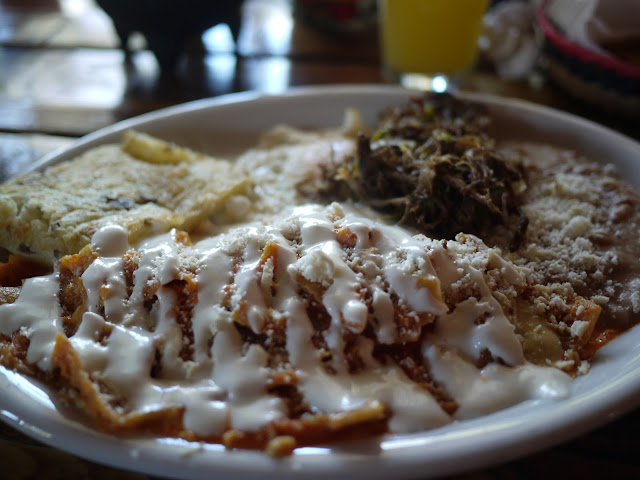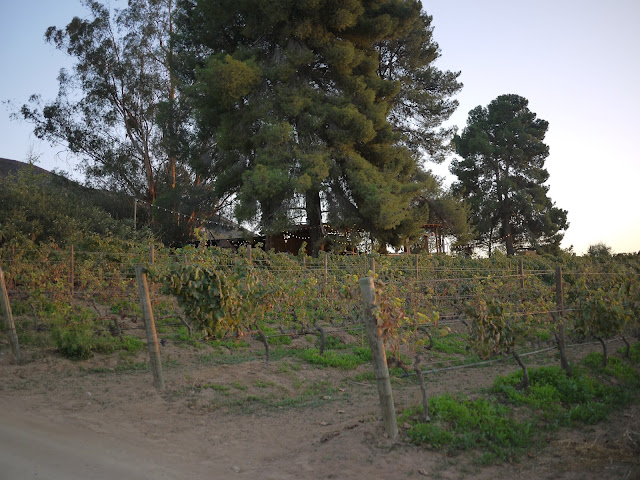Thursday, 17 November 2016
Cheese and Biscuits on Tour - Baja California and the Valle de Guadelupe, Mexico (part 1)
The Valle de Guadalupe is a winemaking area in northern Mexico, about 45 minutes drive from the US border. No, I'd never heard about it either, but then that's hardly surprising given the miniscule profile Mexican wine has in the UK. When was the last time you saw anything from Mexico on a list? A quick CTRL+F of some of the largest lists in London (The Greenhouse, Restaurant Gordon Ramsay, Le Gavroche, the Ledbury, Alain Ducasse at the Dorchester) unearths not a single bottle from that part of the world. Even Mestizo, London's most notable (and since the sad closure of Santo Remedio, best, though that's not saying much) Mexican restaurant has a grand total of one producer on its menu, L.A Cetto; from the Valle de Guadalupe, yes, but it's still hardly a ringing endorsement.
But then Mexican wine in London suffers from pretty much the same fate as its food - under-represented, under-appreciated, unloved. It's a near-impossible task to convince anyone from the UK brought up on Old El Paso fajitas (shudder), Las Iguanas chain restaurants (heave) and any number of high street burrito joints using those weirdly spunky boil-in-the-bag tortilla casings that Mexico has one of the most dynamic and sophisticated food cultures in the world, and that the dross sullying its fine name on our shores has about as much in common with real Mexican food as a bown of real Japanese ramen does to a Pot Noodle. But you'll have to take my word for it, Mexican food, and particularly the cuisine of Baja California, is endlessly rewarding and generous of spirit, with a style and personality all of its own.
Of course, like any part of the world making a good chunk of its living from tourism (and American tourism at that), there are certain traps - the Leicester and St Mark's Squares of Baja California - where generosity of spirit plays second fiddle to making a quick buck, and where touts roam the streets attempting to snare passing trade with outlandish offers. One of these places is Puerto Nuevo, our choice for a lunch stop on the way to the Valley, and home to Casa de Llangosta.
It wasn't that any of the food at Casa de Llangosta was bad, it just felt a bit polished and production-line, with none of the heart and soul of the food we were to experience for much of the rest of the trip (or indeed had been lucky enough to enjoy in the fabulous taco tour from last year). House clam chowder was decent, and the house salsa punchy and fresh (everywhere in Baja makes their own salsa for dipping tortilla chips, and each are as strikingly different to each other as you can imagine - some thick and earthy, some sharp and light, some mild, some painfully hot), but the main event, spiny lobsters, tasted suspiciously previously-frozen - bland and chewy - and the price per head of $40 for all of the above seemed pretty steep.
Still, no great harm done, and our next stop would soon put things right. We began our wineries tour at Liceaga, a medium-sized operation just off the main road near our AirBnB, whose rosado turned out to be the standout of the 4 or 5 wines that made up the $180 (that's $ for Mexican pesos, not American dollars - same symbol for both, confusingly). Charming service, full-bodied wines and beautiful surroundings would turn out to be a feature of more or less every vineyard in the Valley we visited, and Liceaga set the standard early on with all these things in abundance.
Next was El Cielo, a vast, multi-million-dollar eco-winery and vineyard in the north of the valley, whose 'tastings' began with a tour of the temperature-controlled cellars and a lavishly produced introductory video. Normally I'd shy away from anything so corporate, but it was certainly interesting to see how much money had been ploughed into the Valley in recent years, and you could see where it had all gone - the wines were refined and elegant. A chardonnay was our favourite.
Unbeknownst to us, 2nd November was Mexican Day of the Dead, a day where the cemeteries of Ensenada (the regional capital of sorts) turn into giant carnivals and the whole population turns up to drink and be merry. Sadly, with the populace otherwise engaged there wasn't a huge number of people left to run the restaurants of the Valle de Guadalupe, and having decided against the rather expensive steakhouse attached to El Cielo, we soon realised that, well, there weren't a great deal of other options. Eventually after a rather fraught chase through closed restaurant after closed restaurant as the night closed in, we ended up by the side of the road eating hot dogs from a stall. And whether it was our sheer relief to have found anywhere open, or because the Mexicans generally know how to make the most out of any given foodstuff, or both, these hot dogs were pretty much the best any of us had eaten in our lives. I'm just sad I don't know what they guy selling them was called or even how to find him again. Still here is where he was that night in case you're ever in the area yourself and fancy trying the World's Best Hot Dogs.
Day Two began with a very traditional Mexican breakfast at the charming Casa Lupita, hidden (and I really do mean hidden) in the maze of dust roads surrounding the AirBnB. One of the more astonishing things about the Valle de Guadelupe is that aside from a few vineyards and restaurants positioned on the main strips, everything is tucked away down unlikely potholed backroads, vaguely signposted if you're lucky but more often than not just relying on word of mouth directions. More than once we'd given up on a particular recommendation because the increasingly tiny and cratered tracks couldn't possibly have led to anywhere with a water supply, only to give it another go later and realise that just a few bumpy minutes more we'd turn the corner to a huge, swanky vineyard with gravel drive and pretty outdoor furniture.
Anyway Lupita was great, from the sopes to start to the generous combination plates of chilaquiles rojos, machacha, frijoles and fried potatoes which I think I ate about 10% of before admitting defeat. Everything was fresh, vibrant and generous both in the sense of the spirit of generosity and the more tangible sense of the portion size, and served with an easy charm.
Ensenada is enough of a tourist attraction to have the odd strip of dive bars and shops full of jokey tat, but enough of a living, breathing coastal town to have proper, grown-up restaurants and some interesting parks and museums. The fish market was worth a quick look but seemed a bit depleted, possibly due to the dia de los muertos celebrations the day before, but was on the way to our lunch spot of Muelle 3, a bright seafood bar near the harbour where we ate an interesting ceviche spiked with either soy or Maggie's sauce (we couldn't decide; either way it was very nice) and octopus with huitlacoche.
Back in the Valley again after the Ensenada jaunt, and fortified by a dip in the icy cold AirBnB swimming pool (it's the night-time temperatures that dictate the habitability of the pool, apparently, and night-times in the Valley in November are chilly), we trotted next door to another fantastically swanky vineyard tucked on an unlikely backroad called Tres Valles. Tastings here are held in a kind of treehouse above a carpet of dried grapes, and the vineyard grounds are decorated by huge metal animal sculptures by a local artist. Their wines, again leaning towards powerful reds like Cabernet Sauvignon, Tempranillo and Petit Syrah, were silky smooth, and being the only people in the place (again) we had all the time in the world to enjoy them.
We were clearly getting the hang of things now, and in stark contrast to the tribulations of the night before, dinner on day two was booked, recommended, and about as far away from a roadside hot dog stall as you could possibly imagine. Drew Deckman is a decorated American chef who's settled in Baja after various positions in restaurants around the world, and in this exquisite spot overlooking the Mogor vineyard serves exciting modern cuisine using ingredients from their own kitchen gardens, and fish and meat from the wider Baja peninsula.
It's easy to be dazzled by the surroundings at Deckman's even before you get to the food; there is no finer way to end the day than to watch the sun go down over the Valley, watching chefs busy themselves in the open garden kitchen and enjoying wine made from grapes growing on vines literally yards away. But fortunately, the food more than lived up to the incredible setting, from sensitively dressed local oysters, through ox tongue and percebes, grilled valley quail and sweet pickled veg. Only a rather dry pork belly course and the strange compulsion of the staff to rush us through dinner as fast as humanly possible (the whole thing was over in about 20 minutes) took the sheen off slightly. Still, look at that bloody view.
And we were only halfway through. Watch this space for part two.
Labels:
Baja California,
mexican,
Mexico,
Wine
Subscribe to:
Post Comments (Atom)

























No comments:
Post a Comment